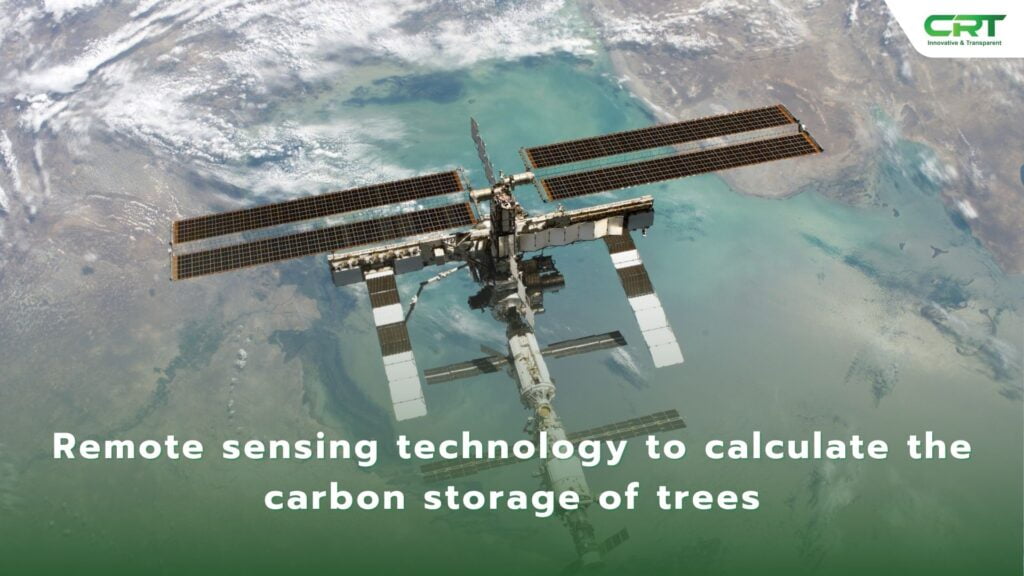The issue of global warming and the increasing levels of greenhouse gases in the atmosphere is a problem that requires international cooperation to find solutions. One of the important approaches is to increase green areas or plant trees to absorb carbon dioxide from the atmosphere and store it. However, measuring the amount of carbon sequestered in trees and forests is challenging and requires complex methods. Currently, the carbon sequestration of trees is calculated using field sampling methods. This method has several limitations, such as being time-consuming, costly, prone to errors, and potentially damaging to the environment. For this reason, remote sensing technology has been applied to improve the efficiency of calculating the carbon sequestration of trees.
Advancements in Remote Sensing Technology
Remote Sensing Technology refers to the collection and analysis of data about objects or phenomena on the Earth’s surface without direct contact with the source of the data. This technology comprises various instruments such as Earth observation satellites, remote sensing radars, and aircraft equipped with cameras or sensors. These devices can capture images and collect spatial data from different perspectives, including electromagnetic waves that are invisible to the human eye.
Remote sensing technology has experienced significant advancements, enabling more accurate and detailed data acquisition over large areas. Satellites with higher spatial and spectral resolution provide improved imagery and data quality, facilitating better analysis and monitoring of environmental conditions, land cover changes, and natural resources.
Furthermore, advancements in data processing capabilities, including powerful computing systems and advanced algorithms, have enhanced the ability to extract valuable information from remote sensing data. This includes techniques such as image classification, object detection, and change detection, which are crucial for applications like urban planning, agriculture, forestry, and environmental monitoring.
The integration of remote sensing data with geographic information systems (GIS) and other data sources has also expanded the applications and usefulness of this technology. By combining remote sensing data with ground-based measurements, models, and other relevant information, researchers and decision-makers can gain a more comprehensive understanding of various phenomena and processes on the Earth’s surface.
Overall, the advancements in remote sensing technology have revolutionized the way we observe and study the Earth, providing valuable insights for environmental monitoring, natural resource management, and sustainable development efforts.
Remote sensing technology to calculate the carbon storage of trees
Once data is obtained from remote sensing technology, it is analyzed and processed to assess the condition of forests, and green areas, as well as the amount of carbon sequestered in various plant species. Techniques such as comparative observation, land cover classification using spectral data from imagery, and detailed analysis of the size, shape, and structure of forests are employed. By processing large datasets and employing sophisticated models, carbon sequestration can be calculated with relative accuracy at various levels, from small areas to regional, national, or even continental scales. The advanced data processing capabilities allow for the precise quantification of carbon storage from the micro level up to broader landscapes.

Utilizing Remote Sensing Technology to Calculate Carbon Sequestration of Trees
Satellite Imagery Analysis: High-resolution satellite imagery can be used to identify tree species, measure tree heights, and assess forest density. This information can be used to create mathematical models to calculate the amount of carbon stored in forests.
LiDAR Application: LiDAR is a remote sensing technology that uses lasers to measure distances and create 3D models of the Earth’s surface. LiDAR data can be used to generate accurate models of tree structure. This information can be utilized to calculate the amount of carbon sequestered in tree biomass.
Radar Utilization: Radar is a remote sensing technology that uses radio waves to detect and measure objects on the Earth’s surface. Radar data can be used to identify tree species and assess forest density. This data can be incorporated into mathematical models to calculate the amount of carbon stored in forests.
Advantages and Benefits
The application of remote sensing technology to monitor and calculate carbon sequestration in forest areas offers several advantages and benefits, including:
- High accuracy and precision, as the data is highly detailed and covers extensive areas.
- Ability to survey large areas quickly, saving time and labor.
- Continuous monitoring and comparison of forest changes and carbon flows.
- Enables effective planning for green area conservation.
Limitations and Challenges
Despite the numerous advantages, the use of remote sensing technology also presents some limitations and challenges, such as:
- Environmental interference like clouds, fog, and heavy rain can prevent data collection during certain periods.
- Relatively high costs for acquiring modern equipment and maintaining the systems.
- Complexity of data and computational models requires specialized expertise.
- Multitude of environmental factors influencing the accuracy of measurements.
Conclusion
The application of remote sensing technology to assess and monitor carbon sequestration in green areas and forests represents a significant scientific advancement. These technologies, including Earth observation satellites, radar, and aerial photography, can provide spatial data that is more detailed, comprehensive, and accurate than traditional survey methods.
Through processing large and complex datasets using various models, scientists can calculate the amount of carbon sequestered in vegetation with high precision, ranging from small areas to entire countries or continents. This is extremely beneficial for planning and monitoring the conservation of green areas.
Although these technologies have certain limitations and challenges, such as high costs, environmental interference, and data complexity requiring specialized expertise, the overall application of remote sensing technology is a crucial step in addressing global warming and environmental impacts. It is expected that these methods will continue to be developed to provide even more accurate and efficient data in the future.
Remote sensing represents a powerful tool in the fight against climate change, enabling improved quantification and understanding of the vital role of forests and vegetation in carbon sequestration. As technology advances, remote sensing will play an increasingly important role in environmental conservation and sustainable development efforts worldwide.
ที่มาข้อมูล:

